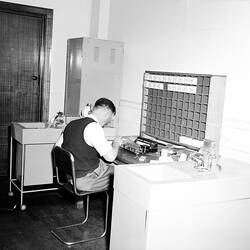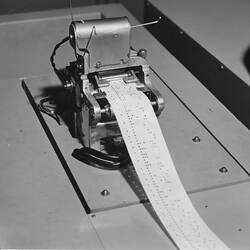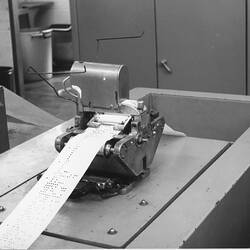Summary
Paper tape, part of a collection of paper tape programs and sub-routines used for input to CSIRAC. The Primary & Control Program was used to enable a program to be run on CSIRAC.
The collection includes the original University of Melbourne Computation Laboratory Paper Tape Library of 12 hole tapes of subroutines and programs, and program and data tapes from staff and outside users.
Most of the paper tapes were 12-track punched paper tapes. 5 hole paper tapes were used primarily for data input and output rather than program input. However, 5 hole program tapes could be produced by using Interprogram, an English language programming system rather than using machine language.
Each tape has a 'T' number. The Computation Laboratory Paper Tape Library consisted of tapes with a tape number less than 700. There were not 700 tapes but the number 700 was arbitrarily chosen to separate the Computation Laboratory Library tapes from user tapes.
Details of this tape:
The Primary & Control Program was used to enable a program to be run on CSIRAC. It contained about 40 instructions.
This particular version of the program was in in the CSIRAC Paper Tape Library.
CSIRAC did not have any read only memory which would retain instructions when the computer was turned off.
These instructions enabled user programs to be loaded and executed. When started from the switch panel on the console, the "primary and control" program instructed the computer to read the user's program (including sub-routines) from paper tape and store it in the memory.
A description of this program and how to load it appears in the CSIRAC Programming Manual.
This particular version of the Primary & Control program enables the user to keep some information in the D registers and some in the high end of memory, where it would not be overwritten by a new program that was being loaded. Generally programs were loaded at the low end of memory, building up to the high end..
When read only memory became available in the 1970s, these functions were automatically performed when the computer was switched on.
More Information
-
Collection Names
CSIRAC Collection, CSIRAC Archive Collection, CSIRAC Paper Tape Library Collection
-
Collecting Areas
-
Acquisition Information
Donation from Computer Science & Software Engineering Department, University of Melbourne (The), by Jul 2003
-
User
University of Melbourne (The), Grattan Street, Parkville, Greater Melbourne, Victoria, Australia, 1955-1964
-
Format
Paper Tape, 12 hole
-
Classification
-
Category
-
Discipline
-
Type of item
-
Keywords
Computing, CSIRAC (Computer), First Generation Computers, Mainframe Computers, Making History - CSIRAC



